
Understanding SOLID: The Core Principles of Object-Oriented Design
SOLID is an acronym for five design principles intended to make software designs more understandable, flexible, and maintainable. Developed by Robert C. Martin (also known as “Uncle Bob”), these principles are a cornerstone of object-oriented programming. By applying SOLID, developers can build robust and scalable systems that are easier to debug and extend.
The five principles are:
- Single-Responsibility Principle
- Open-Closed Principle
- Liskov Substitution Principle
- Interface Segregation Principle
- Dependency Inversion Principle
Let’s explore each one with practical examples.
1. Single-Responsibility Principle (SRP)
The Single-Responsibility Principle states that a class or a module should have only one reason to change. This means each class should have a single, well-defined responsibility.
Bad Example (Violation)
Here, the User class handles multiple responsibilities:
- Managing user data (name, email)
- Persisting user data to a database
- Sending a welcome email
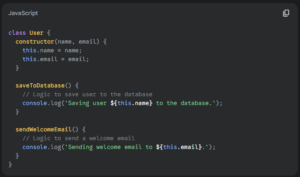
This violates SRP because if the database changes or if the email sending service changes, you have to modify the User class.
Good Example (Adherence)
We separate the concerns into different classes.
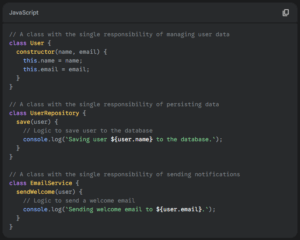
Now, each class has a single responsibility. If the database logic changes, we only need to modify User Repository. If the email service changes, we only touch Email Service.
2. Open-Closed Principle (OCP)
The Open-Closed Principle states that software entities (classes, modules, functions, etc.) should be open for extension, but closed for modification. This means you should be able to add new functionality without changing existing code.
Bad Example (Violation)
This ShapeCalculator class needs to be modified every time a new shape is added.
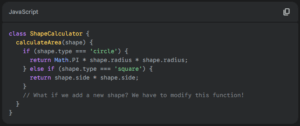
Good Example (Adherence)
We use a common interface or base class and extend it.
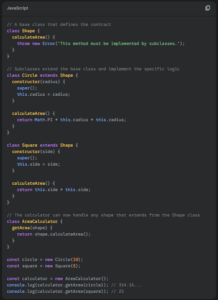
Now, if we add a Triangle class, we just need to extend Shape without ever modifying the AreaCalculator.
3. Liskov Substitution Principle (LSP)
The Liskov Substitution Principle states that objects of a superclass should be replaceable with objects of its subclasses without affecting the correctness of the program. In simpler terms, a subclass should be able to do everything its parent class can do, and more, but never less.
Bad Example (Violation)
Consider a Bird class with a fly method.
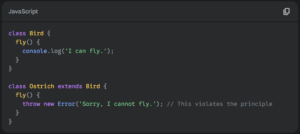
The Ostrich subclass breaks the contract of the parent class by throwing an error. A function expecting a Bird and calling fly() would now fail if an Ostrich instance is passed to it.
Good Example (Adherence)
To fix this, we should restructure our hierarchy.
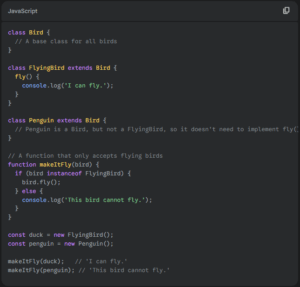
The principle is respected because Penguin doesn’t pretend to be something it’s not.
4. Interface Segregation Principle (ISP)
The Interface Segregation Principle states that clients should not be forced to depend on interfaces they do not use. Put simply, prefer many small, specific interfaces over one large, monolithic one.
While JavaScript doesn’t have native interfaces, we can apply this principle conceptually using objects or base classes with defined methods.
Bad Example (Violation)
This Worker “interface” is too broad.
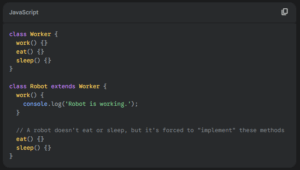
The Robot class is forced to depend on methods (eat, sleep) that are irrelevant to it. This adds unnecessary complexity and potential for bugs.
Good Example (Adherence)
We segregate the responsibilities into smaller, more focused “interfaces.”
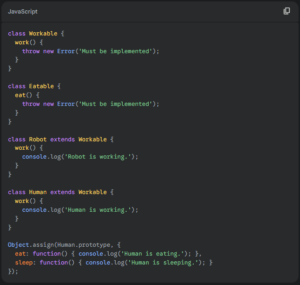
The Robot only depends on the Workable interface, which is what it needs. A Human can extend from Workable and then add other relevant behaviors like eat and sleep.
5. Dependency Inversion Principle (DIP)
The Dependency Inversion Principle states that high-level modules should not depend on low-level modules. Both should depend on abstractions. Secondly, abstractions should not depend on details; details should depend on abstractions.
This principle is about decoupling your code. Instead of a concrete class depending on another concrete class, both depend on an abstract interface.
Bad Example (Violation)
The Backend class is a high-level module, but it’s tightly coupled to the low-level MySQLDatabase concrete class.
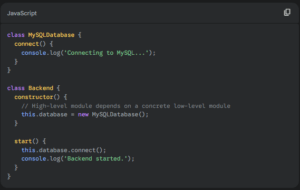
If we want to switch to a different database (e.g., PostgreSQL), we have to change the Backend class directly.
Good Example (Adherence)
We introduce an abstraction (a common interface) that both high-level and low-level modules depend on.
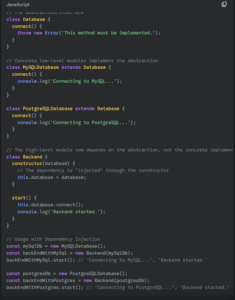
By inverting the dependency, the Backend is no longer concerned with the specific database type. This makes the system far more flexible, testable, and easier to scale. This is the foundation of a pattern called Dependency Injection (DI).
In essence, the SOLID principles are not rigid rules but rather a set of guidelines for writing better, more maintainable code. By following them, you create software that is more resilient to change, easier to understand, and more collaborative to work with. Embracing these principles allows you to build a clean and robust architecture, ensuring your applications stand the test of time and remain flexible as they grow. Ultimately, SOLID is a pathway to crafting professional-grade software that is a pleasure to develop and evolve.
Why iClick Online Technology?
At iClick Online Technology, we help businesses in Australia leverage the power of custom software development, WordPress website design, Shopify integrations, and AI-powered solutions.
Whether you’re looking for a mobile app developer in Melbourne, a Shopify development partner in Sydney, or a cloud-ready software development company in Australia, our team builds scalable systems guided by SOLID principles and agile methodologies.
We blend technical expertise, user-centric design, and innovative AI development to deliver future-ready solutions that grow with your business.
Lets create something extraordinary. Partner with us.
Start by saying hello